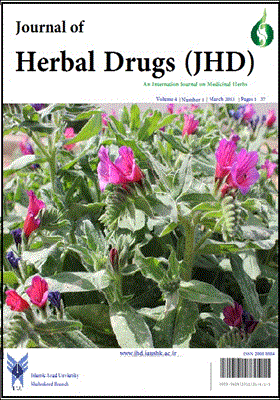-
-
List of Articles
-
Open Access Article
1 - Comparison of the antibacterial, antiplaque and anti-gingivitis activity of herbal mouthwash with chlorhexidine in dog
سعادت مشکلانی محمد جواهری کوپایی حسن ممتاز -
Open Access Article
2 - Folk Herbal Veterinary Medicines of Zilberchay Watershed of East Azerbaijan (Iran)
اردوان قربانی فرزاد میرزایی رقیه ولی زاده یونجالی -
Open Access Article
3 - Evaluation of chemical composition, anti-inflammatory and anti-nociceptive effects of Eugenia caryophyllata buds essential oil
عماد خلیل زاده رضا حضرتی غلامرضا وفایی سیاح -
Open Access Article
4 - Antioxidant activity of the extracts from Salvia officinalis, Brassica oleracea, Juglans regia, Melilotus officinalis, and Crataegus oxyacantha at different temperatures
محمد مؤمن هروی شهلا دانش مهر علی مرسلی -
Open Access Article
5 - Effect of the extract from Gundelia tournefortii on immature mouse oocytes
آزاده عابدی لیلا روحی عبداله قاسمی پیربلوطی -
Open Access Article
6 - Neuroprotective role of vitamin E, green tea extract, and spirulina in rats treated with cadmium chloride
امیر علی شهبازفر سید جمال امامی رضا اسدپور -
Open Access Article
7 - Quantitative estimation of different phytoconstituents in Alangium salvifolium parts: A comparative study
اس.وی بدگوجار اس.اچ میشرا -
Open Access Article
8 - Chemical composition of essential oil from the aerial parts of Salvia spinosa L. collected from Isfahan
سعید صالحی احمد رضا گل پرور امین هادی پناه
-
The rights to this website are owned by the Raimag Press Management System.
Copyright © 2021-2025







